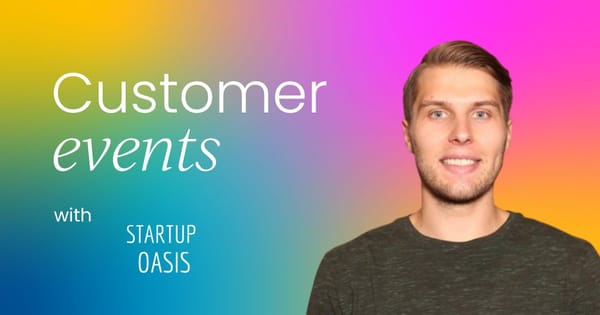Throughout my career, I’ve worked in customer experience, engagement, and advocacy across industries – startups, political campaigns, hospitality, brick-and-mortar businesses, and enterprise software.
But through it all, there’s been one constant in every role: the power of bringing people together.
My focus has always been on building relationships and influencing shared outcomes between customers and internal teams. One of the most effective ways I’ve found to do that is through customer events – interactive spaces where product, support, and customers connect directly.
But don't think of events purely in terms of engagement. Actually, they’re about alignment: turning feedback into collaboration, collaboration into advocacy, and advocacy into customer-led growth.
Where the idea comes from
My approach to customer events is rooted in years of organizing gatherings across very different sectors. I’ve seen what works in high-touch environments, from in-person meetups to digital communities. The foundation is always the same: start with listening – both internally and externally.
Before planning any event, I sit down with internal teams to learn their goals and desired results. What do they need from customers? What outcomes matter most? Then I validate those ideas directly with customers.
In my experience, customers consistently express interest in webinars and sessions led by product managers and support technicians – a space to ask questions, understand roadmaps, and learn directly from the experts. Sharing that feedback internally often helps secure buy-in from product teams, since it clearly shows demand from the people who matter most.
As Ari Hoffman, Head of Enterprise Executive Engagement Programs at Lighthouse GTM, notes:
“Often the product team can feel so removed from the customer. What Rob is doing is building that bridge, so the product team understands who they’re building for.”
That’s exactly the goal. These events exist to shorten the distance between the people building the product and the people using it.
Why events matter
For me, the customer experience is the primary motivation behind every event. If the experience is right, the business outcomes follow.
Of course, other teams benefit too:
- Product gets direct, unfiltered feedback.
- Marketing gets authentic stories.
- Customer Success learns where customers need more support.
But the heart of it all is trust. When customers engage regularly, they naturally build rapport and confidence with the company. They buy more, refer more, and advocate more... all without being asked.
As Ari put it, “You focus on the experience first, and the byproduct is the revenue that follows.”
Planning and collaborating with product
Creating alignment with product teams takes time. In one of my previous roles, I transitioned from customer success into product marketing to strengthen collaboration and access more resources. That shift helped me understand both sides – how customer-facing teams gather insight, and how product teams act on it.
Today, I use that same cross-functional mindset to connect product, marketing, and customer success through events. The goal is to nurture customers until they feel confident enough to share their stories publicly. Events help create that comfort – they turn users into advocates and advocates into trusted partners.
While I’m largely self-sufficient in producing events, collaboration is key. I always start by asking product teams what insights they need and how the event can help them achieve their goals. Then I position it as a light lift: they simply need to show up and share their expertise.
Making it about the customer first – and showing how that benefits everyone – consistently wins buy-in.
The impact of customer events
The impact of customer events speaks for itself. In one instance, when the product and sales teams needed beta testers for a new platform, I proposed hosting a customer webinar and inviting qualified users.
That session drew over 200 attendees and generated 50 beta sign-ups in a single day– far exceeding our target.
Later, a quarterly product summit brought together more than 500 customers to hear roadmap updates and participate in live Q&A sessions with product leaders. Seeing customers answer each other’s questions alongside our teams was a clear sign that community and advocacy were working in tandem.
These events don’t just create excitement—they surface real market insights and customer needs. They give us a live feedback loop that influences the roadmap and strengthens the customer voice across the organization.
I believe the future of growth is customer-led. Companies that stay close to their customers – I mean, really close – will always build the right things faster.

4 key lessons learned
Through years of experience producing customer events, I've learned some invaluable lessons:
1. Stay nimble
When launching a customer marketing or advocacy program, don’t wait for perfection. Get customers together quickly—even if it’s a small meetup or a pilot session. You can iterate later. The key is showing up and starting the conversation.
2. Prioritize accessibility
Make every event easy to join, easy to understand, and easy to follow up on. Internally, use all-hands or AMAs to spread awareness so more teams can participate. The smoother the experience, the more people—inside and outside the company – will rally behind it.
3. Continue the conversation
A single event isn’t the goal; ongoing dialogue is. Customers appreciate direct access to PMs and technicians, so I make that a consistent part of programming. Leveraging an advocacy hub or customer community helps sustain those connections year-round.
Ari summed it up well:
“Don’t ever let customer feedback disappear into silence. If you don’t close the loop, people stop believing their input matters.”
4. Build internal advocacy first
One of the biggest insights I’ve gained is that internal advocacy fuels external advocacy. Hosting internal AMAs or team happy hours gives colleagues firsthand experience of what a meaningful connection feels like – and motivates them to replicate that for customers.
Conclusion
A good part of customer events are about showcasing products. It's a given. But what most people overlook is the opportunity to build partnerships – between customers, product teams, and every department that shapes the experience.
When you bring people together to learn, collaborate, and solve problems, you create more than engagement. You create momentum: trust that scales, loyalty that compounds, and advocacy that grows naturally.
I’ve seen it across every stage of my career: when you lead with the customer experience, growth follows.
This article is based on Robert's appearance on the Customer Marketing Catch-up podcast. You can listen to the full conversation with Ari Hoffman and Robert Maddox here.


 4 min read
4 min read
 Follow us on LinkedIn
Follow us on LinkedIn



